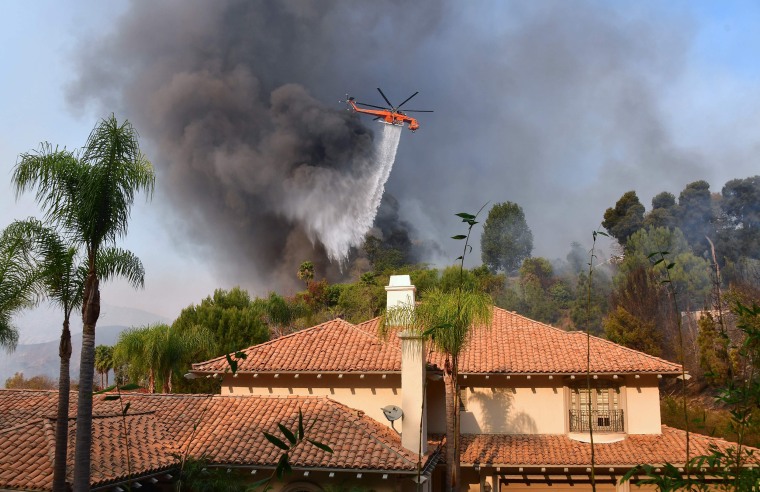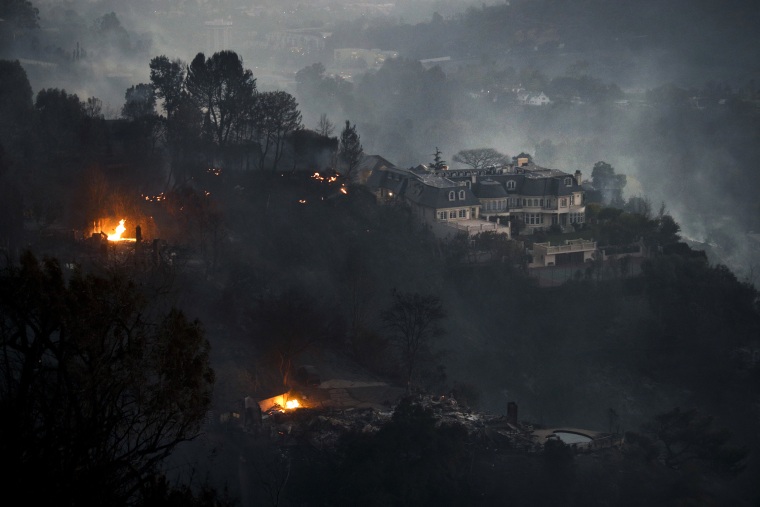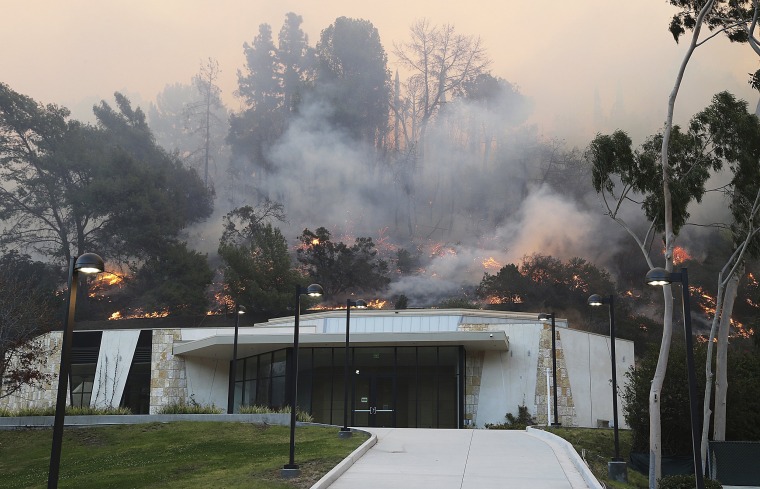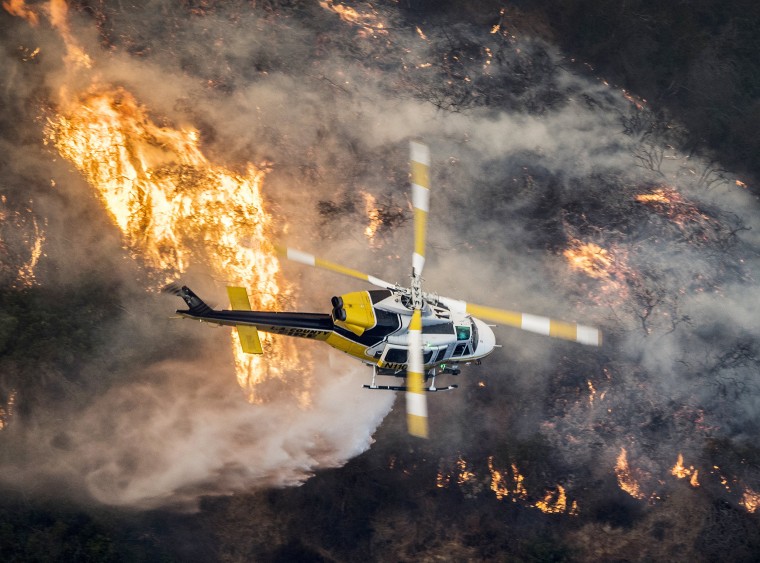BEL-AIR, Calif. — Around midday Wednesday, Bel-Air had that picture postcard feel: 70-something temperatures under a bright blue, cloudless sky. It was the kind of mid-winter day that, for decades, lured Hollywood magnates and movie stars to these fortune-kissed hillsides.
But something unsettling crept in around the edges of this year's winter idyll — a whiff of smoke, a light sprinkling of ash, and a steady flow of water down the gutter. Many residents here, in one of Los Angeles' poshest neighborhoods, awoke to find waves of fire leaping up the steep hillsides of the Sepulveda Pass, the main route connecting the city’s Westside with the famed San Fernando Valley.
Photos: Wildfire devours homes in Southern California
This impossibly pleasant and cossetted world was, once again, facing a force that no amount of money or preparation could completely control. By late morning, at least four sprawling homes had burned and a firestorm fueled by 30 mile-an-hour winds had come within a loose ember of some of Los Angeles’s best-known cultural institutions.

While a dampening of wind and relentless work by firefighters had controlled the blaze during the day Wednesday, the return of gusts in the evening had homeowners and firefighters on edge.
“I am just hoping everything will be all right,” said Peggy Hattendorf, a writer and one-time magazine editor who has lived on a Bel-Air hillside for much of the last 35 years. “When the winds kick up, it will scare the Bejeezus out of everyone.”
Spared so far were several museums, schools and synagogues that are mainstays of the city’s cultural life.
The Getty Center and its world-renowned art collection stood, untouched, on the west side of Interstate 405, an area that fire officials said they were determined to prevent from getting caught up in the conflagration.

Farther up the broad canyon, the Skirball Cultural Center, American Jewish University, the Stephen Wise Temple and the Leo Beck Temple all remained unscathed.
The American Jewish University had evacuated all of its 150 undergraduate and graduate students by 8:45 a.m. (11:45 a.m. ET). Many had left a day earlier, when the school closed because the air had already been fouled by fumes from a fire to the north, in Ventura County.
As a precaution, the school gathered five full-sized Torah scrolls and one mini Torah scroll and moved the sacred texts — some more than 100 years old and brought from Eastern Europe — to its satellite campus in Simi Valley.
"When the winds kick up, it will scare the Bejeezus out of everyone"
The closest call for the many landmark Jewish organizations in the area was for the Leo Beck Temple, whose driveway is directly east of the main entrance to the Getty Center. Firefighters reached the synagogue, the frequent scene of cultural events and political debates, before dawn on Wednesday. They helped stop the flames just a few feet from the temple's back door.
Fire crews rested and regrouped in the temple parking lot Wednesday afternoon, after a day putting out hotspots and embers. “We are making sure nothing touches off here and blows to the other side of the freeway,” said James Altman, a battalion chief with the Santa Monica Fire Department, one of the many agencies called from around the state to pitch in. “We have worked all day to prevent that, which would be our worst-case scenario.”
As the sun set Wednesday, the fire seemed under control, but the National Weather Service put out an unsettling bulletin. “Extremely critical fire weather conditions tonight-Thursday," it said, "as strong and damaging #SantaAnaWinds combine with single digit humidities. Very rapid fire spread, long range spotting, and extreme fire behavior likely.”
People who live here said they have come to expect that, every few years, their lives can be turned upside down.

The biggest fire disaster in the area came in 1961, destroying more than 500 homes. That Bel-Air firestorm was notable for the celebrities — like Zsa Zsa Gabor and Burt Lancaster — who lost their homes and for prompting Los Angeles to toughen its fire code.
Brush clearance requirements were imposed around homes and wood shingle roofs, which burn like kindling in a fire, were banned. Fire officials said those improvements undoubtedly helped spare homes more than half a century later, in this week's big burn.
Michel Ohayon, who has lived in the Bel-Air area for 25 years, said he awoke about 5:15 a.m. to the smell of smoke. He and his family packed some jewelry, pictures and memorabilia. The others left, while Ohayon stayed behind to help ensure that a friend’s home was safe.
Related: Los Angeles threatened as wildfires spread, forcing thousands to evacuate
“We’re somewhat worried, but what can you do?” Ohayon said. “It’s life. We live in California... Some people live in Florida, they have hurricanes. We live here — earthquakes and sometimes this.”
Others said they were attracted to Bel-Air not just for the stunning weather, but for its laissez-faire vibe — not as urban as nearby Westwood, home of the UCLA campus, or quite as remote as Malibu, up the coast.
“Bel-Air is a very special part of the world,” said Fred, a 57-year-old, whose declined to give his last name and whose family moved to the neighborhood before he started elementary school. “There is a lot of sense of community, but we still have our elbow room and independence at the same time.”
The biggest headache before this week’s fire has been a recent spate of mansionization, or something even more extreme—mansions being turned into compounds. (A fire official quipped that it was hard to say if all the structures burned Wednesday were homes, since many pool houses and cabanas here are big enough to live in.)
Last summer, real estate developer Mohamed Hadid — father of supermodels Bella and Gigi Hadid — pleaded no contest to criminal charges tied to his construction of an illegal mega-mansion in Bel-Air. The city had not approved the size or height of the home, which some neighbors considered a blight on a community which abided big, but recoiled at colossal. Hadid had to stabilize the hillside underneath the massive home and pay fines and complete community service.
“People get away with what they can,” said Fred. “Mansions are being surrounded by monster developments and a lot of them are owned by some LLC. No one knows who the real owner is…maybe some foreign prince.”
Residents here concede the fires create anxious moments, but almost all said they can’t imagine living anywhere as sublime. Some homes have sweeping views of the lights of West Los Angeles. When the traffic is right, a local can be on the beach in Santa Monica in less than 10 minutes.

But others said Wednesday's fire was a disaster too far. Bianca Kaveh and her husband awoke to a “firewall” outside their window. “All I saw was orange – I didn’t even see sky,” Kaveh said. Her husband stayed behind when she evacuated, using a garden hose to help save their home.
That was heroic, as were the firefighters who Kaveh said appeared out of the dark, “like Superman, to save the day.” But Kaveh said she is ready to move. “I I can’t live here. I’m so traumatized," she said. "I know fires happen, but they’re happening more and more, there’s no way I’m going to stay here anymore ... I’m scared to live here.”
One other landmark, at least for locals, also made it through the first day of what had been named the Skirball Fire. That was media magnate Rupert Murdoch’s home and hillside winery, known as Moraga Bel Air.
The estate, which Murdoch reportedly bought in 2013 for $30 million, appeared to have lost a few of its grape vines and according to the owner, suffered some damage "to buildings in the upper vineyard." But the sprawling home at the bottom of the hill remained unscathed. A helicopter made several water drops into the afternoon, while two fire engines waited at the bottom of the hill, outside the property’s main gate.
Murdoch thanked the first-responders for their quick work and sent word, in a statement, that he was thinking of his neighbors and saying “our thoughts and prayers are with them at this difficult time.”
